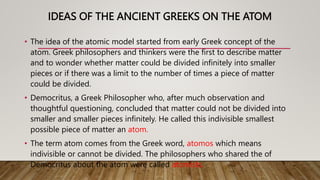Lesson3_Theory of Atomic Structure Models.pptx
•Download as PPTX, PDF•
0 likes•1 view
Physics Theory of Atomic
Report
Share
Report
Share

Recommended
More Related Content
Similar to Lesson3_Theory of Atomic Structure Models.pptx
Similar to Lesson3_Theory of Atomic Structure Models.pptx (20)
Chapter 3.1 : The Atom: The Building Blocks of Matter

Chapter 3.1 : The Atom: The Building Blocks of Matter
PhySci-01-Unit-1-Chapter-1-Lesson-1.3-Atoms-from-the-Eyes-of-Philosophers-and...

PhySci-01-Unit-1-Chapter-1-Lesson-1.3-Atoms-from-the-Eyes-of-Philosophers-and...
Lesson 5: Corpuscles to Chemical Atomic Theory (The Development of Atomic The...

Lesson 5: Corpuscles to Chemical Atomic Theory (The Development of Atomic The...
Recently uploaded
https://app.box.com/s/7hlvjxjalkrik7fb082xx3jk7xd7liz3TỔNG ÔN TẬP THI VÀO LỚP 10 MÔN TIẾNG ANH NĂM HỌC 2023 - 2024 CÓ ĐÁP ÁN (NGỮ Â...

TỔNG ÔN TẬP THI VÀO LỚP 10 MÔN TIẾNG ANH NĂM HỌC 2023 - 2024 CÓ ĐÁP ÁN (NGỮ Â...Nguyen Thanh Tu Collection
Mehran University Newsletter is a Quarterly Publication from Public Relations OfficeMehran University Newsletter Vol-X, Issue-I, 2024

Mehran University Newsletter Vol-X, Issue-I, 2024Mehran University of Engineering & Technology, Jamshoro
https://app.box.com/s/x7vf0j7xaxl2hlczxm3ny497y4yto33i80 ĐỀ THI THỬ TUYỂN SINH TIẾNG ANH VÀO 10 SỞ GD – ĐT THÀNH PHỐ HỒ CHÍ MINH NĂ...

80 ĐỀ THI THỬ TUYỂN SINH TIẾNG ANH VÀO 10 SỞ GD – ĐT THÀNH PHỐ HỒ CHÍ MINH NĂ...Nguyen Thanh Tu Collection
Recently uploaded (20)
Unit-V; Pricing (Pharma Marketing Management).pptx

Unit-V; Pricing (Pharma Marketing Management).pptx
TỔNG ÔN TẬP THI VÀO LỚP 10 MÔN TIẾNG ANH NĂM HỌC 2023 - 2024 CÓ ĐÁP ÁN (NGỮ Â...

TỔNG ÔN TẬP THI VÀO LỚP 10 MÔN TIẾNG ANH NĂM HỌC 2023 - 2024 CÓ ĐÁP ÁN (NGỮ Â...
Python Notes for mca i year students osmania university.docx

Python Notes for mca i year students osmania university.docx
80 ĐỀ THI THỬ TUYỂN SINH TIẾNG ANH VÀO 10 SỞ GD – ĐT THÀNH PHỐ HỒ CHÍ MINH NĂ...

80 ĐỀ THI THỬ TUYỂN SINH TIẾNG ANH VÀO 10 SỞ GD – ĐT THÀNH PHỐ HỒ CHÍ MINH NĂ...
Beyond_Borders_Understanding_Anime_and_Manga_Fandom_A_Comprehensive_Audience_...

Beyond_Borders_Understanding_Anime_and_Manga_Fandom_A_Comprehensive_Audience_...
Fostering Friendships - Enhancing Social Bonds in the Classroom

Fostering Friendships - Enhancing Social Bonds in the Classroom
Food safety_Challenges food safety laboratories_.pdf

Food safety_Challenges food safety laboratories_.pdf
Unit 3 Emotional Intelligence and Spiritual Intelligence.pdf

Unit 3 Emotional Intelligence and Spiritual Intelligence.pdf
Kodo Millet PPT made by Ghanshyam bairwa college of Agriculture kumher bhara...

Kodo Millet PPT made by Ghanshyam bairwa college of Agriculture kumher bhara...
ICT role in 21st century education and it's challenges.

ICT role in 21st century education and it's challenges.
Lesson3_Theory of Atomic Structure Models.pptx
- 1. IDEAS OF THE ANCIENT GREEKS ON THE ATOM • The idea of the atomic model started from early Greek concept of the atom. Greek philosophers and thinkers were the first to describe matter and to wonder whether matter could be divided infinitely into smaller pieces or if there was a limit to the number of times a piece of matter could be divided. • Democritus, a Greek Philosopher who, after much observation and thoughtful questioning, concluded that matter could not be divided into smaller and smaller pieces infinitely. He called this indivisible smallest possible piece of matter an atom. • The term atom comes from the Greek word, atomos which means indivisible or cannot be divided. The philosophers who shared the of Democritus about the atom were called atomists.
- 2. CONTRIBUTIONS OF JOHN DALTON TOWARD THE UNDERSTAND OF THE CONCEPTS OF CHEMICAL ELEMENTS • John Dalton, an English teacher and scientist proposed an atomic theory about the indivisible building blocks of matter called atoms. His hypotheses which state in part that the atoms were responsible for the formation of compounds by combining two or more elements can be summarized as follows: • 1. All elements of matter are composed of extremely small particles called atoms. • 2. Atoms of the same element are identical, having the same size, mass and chemical properties. Atoms of one element are different from atoms of another element.
- 3. CONTRIBUTIONS OF JOHN DALTON TOWARD THE UNDERSTAND OF THE CONCEPTS OF CHEMICAL ELEMENTS • 4. A chemical reaction involves only the separation, combination or rearrangement of atoms. It does not result in their creation or destruction. This is the “Law of Conservation of Mass” which states that matter can be neither created nor destroyed. Atomic Theory Proposed by John Dalton 1. Atoms are indivisible particles and all elements are composed of atoms. 2. Same elements have exactly alike atoms. 3. While atoms of same elements are the same, atoms of different elements are different.
- 4. ATOMIC THEORY PROPOSED BY JOHN DALTON • 4. Two or more atoms of same elements can be combined to form compounds. They combine I fixed ratios of whole numbers forming particles of molecules. • 5. Atoms are units of chemical change which involves combinations or rearrangements of atoms where they are not created.
- 5. Models of the Atom
- 21. Prepared by: Ma’am Lhyn